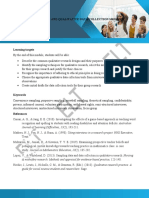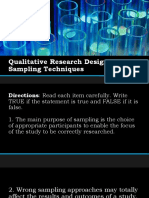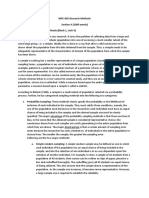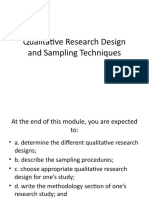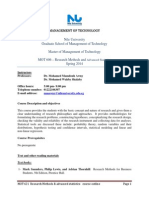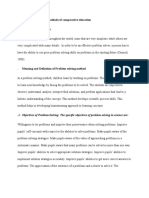Developing Sampling Frame For Case Study: Challenges and Conditions
Uploaded by
Kenneth PuguonDeveloping Sampling Frame For Case Study: Challenges and Conditions
Uploaded by
Kenneth Puguonwww.sciedu.ca/wje World Journal of Education Vol. 4, No.
3; 2014
Developing Sampling Frame for Case Study: Challenges and Conditions
Noriah Mohd Ishak1 & Abu Yazid Abu Bakar2,*
1
Pusat PERMATApintar™ Negara, Universiti Kebangsaan Malaysia, Bangi, Malaysia
2
Faculty of Education, Universiti Kebangsaan Malaysia, Bangi, Malaysia
*Corresponding author: Faculty of Education, Universiti Kebangsaan Malaysia, 43600 Bangi, Selangor, Malaysia. Tel:
60-19-224-6917. E-mail: yazidtldm@yahoo.com
Received: November 16, 2013 Accepted: December 17, 2013 Online Published: May 13, 2014
doi:10.5430/wje.v4n3p29 URL: http://dx.doi.org/10.5430/wje.v4n3p29
Abstract
Due to statistical analysis, the issue of random sampling is pertinent to any quantitative study. Unlike quantitative
study, the elimination of inferential statistical analysis, allows qualitative researchers to be more creative in dealing
with sampling issue. Since results from qualitative study cannot be generalized to the bigger population, qualitative
researchers do not have to endure the strenuous randomization process of sampling procedure. However, qualitative
researchers should not take sampling procedures too lightly, and if they do, it will affect the richness and the
appropriateness of the data. The chances are, the data will not answer their research questions and this can frustrate
the researchers when making meanings to the data. This paper will examine the available methods in sampling
participants for qualitative study. Specifically, the paper will discuss the sampling frame suitable for case study, such
as single-case (holistic and embedded), multi-case, and a snowball or network sampling procedure. Discussion will
also involve challenges anticipated for each procedure.
Keywords: case study; sampling; qualitative sample
1. Introduction
Qualitative and quantitative researchers approach sampling quiet differently. For quantitative researchers, the
primary goal for the sampling procedure is to get a representative sample, small number of individuals but
representative of the bigger population and produce accurate generalization about the population. Therefore,
quantitative researchers are very concern about using specific techniques that will yield highly representative
samples and they tend to use a type of sampling frame based on theory of probability. This is known as probability or
random sampling. According to Neuman (2009) researchers has two motivations for using probability or random
sampling: (1) time and cost effectiveness, and (2) accuracy of the findings. Neuman suggested that “the results of a
well-designed, carefully executed probability sampling will produce results that are equally if not more accurate than
trying to reach every single person in the whole population” (2009, 195).
The same thing cannot be said for a qualitative study. The elimination of statistical analysis, allows qualitative
researchers to be more creative in dealing with sampling issue. They do not have to endure the strenuous
randomization process of sampling procedure because the results cannot be generalized to a bigger population, and
only analytical generalization can be conducted where a particular set of results is generalized to a broader theory
(Yin, 2009). Qualitative researchers focus less on a sample’s representativeness or on detailed techniques for
drawing a probability sample (Neuman, 2009). As such, many authors enlightening qualitative approach as research
methodology never actually discuss sampling procedures, let alone detailing the exact procedure in choosing
research participants or informants (Marshall & Rossman, 2011; Creswell, 2003). The focus has been on how the
small sample or small collection of cases, units, or activities, illuminates’ social life or the phenomenon being
studied. The primary purpose of sampling for a qualitative researcher is to collect specific cases, events, or actions
that can clarify or deepen the researchers understanding about the phenomenon under study. Similarly, their
concerned would be to find cases or units of analysis that will enhance what other researchers have learned about a
particular social life or phenomenon. If they were the pioneers in the field, the concerned would be to find cases that
will help explain deeper their initial understanding about the phenomena that they are studying. For this reason,
Published by Sciedu Press 29 ISSN 1925-0746 E-ISSN 1925-0754
www.sciedu.ca/wje World Journal of Education Vol. 4, No. 3; 2014
qualitative researchers tend to use nonprobability sampling. This paper will examine the available techniques in
sampling participants for qualitative study. Specifically, the paper will discuss sampling techniques suitable for case
study such as single or multiple-case design and snow balling or networking technique for sampling procedure.
Challenges that occur for each procedure will also be discussed.
2. Discussion
2.1 Is My Sampling Frame Big Enough?
Qualitative researchers are not concerned and seldom draw a huge sample from the studied population. Flick (2009)
suggested that the individuals or cases are selected as participants for a qualitative study not because they represent
their population (and therefore, the issue of generalizability) but owing to their relevance to the research topic.
Inevitably, the idea of randomization outmoded the idea of nonprobability sampling or nonrandom sampling.
Qualitative researchers rarely determine their sample size prior to their study nor do they have great ideas or vast
knowledge about the population they are going to study (if they do, then it will defeat the purpose of doing a
qualitative study!) or from which the unit of analysis will be taken from. Concisely, qualitative researchers select
their cases gradually, and not limiting the number of selected participants until the data reached saturation point.
Glesne and Peshkin (1992) suggested that the number of participants for a qualitative study could be determined by
looking at the data during data analysis. If repetition of stories occurs among participants and no new information
awarded to the researchers by any new participants, then the data is said to reach a satiation point. The researchers
can then stop selecting new participants for their study. The following diagram (Figure 1) describes this.
Participant 1: Participant 2: Participant 3: Participant 4:
Talks about Talks about Talks about Talks about
Factors: A, B Factors: A, B, C Factors: A, B, Factors: A, B,
C, and D C, and D
Saturation Point
Participants 5 and 6:
Talks about Factors: A, B, C, and D
(Saturation point is reached)
Figure 1. Indicators for Saturation Point
Can the saturation point determine the number of samples that will provide enough data to explain the phenomenon?
What happened if the researcher is not able to find the saturation point? The response to both questions will have to
depend on the research questions formulated for the study and the interview protocol used to collect the data.
Saturation point will not evolve (and therefore, the number of samples will not be able to be determined) if the
Published by Sciedu Press 30 ISSN 1925-0746 E-ISSN 1925-0754
www.sciedu.ca/wje World Journal of Education Vol. 4, No. 3; 2014
interview protocol used is not exhaustively developed. Therefore, the researcher will have to go back to more
samples and the new revised interview protocol that encompassed more exhaustive questions. Concomitantly, the
interview protocol would have to be in-line with the research questions. The researcher would have to do some
reflection process (or develop a memoir) every time a set of data is collected from a sample. This is a continuous
analytical process that becomes part of the data analysis procedure and can be quiet a cumbersome process. The
challenge is for the researcher to develop very comprehensive research questions that will leave no stone unturned.
Exploration on every aspect of the phenomenon will have to be reviewed and identified to ensure comprehensiveness
of data and manageable number of samples.
2.2 Shall I Just Choose One or Go For More?
Putting the above idea into its perspective, therefore, a single-case study can sometimes be sufficient to explain
certain phenomenon, particularly one with critical or classic characteristics. Yin (2009) suggested that single-case
study could be the appropriate design under several circumstances.
First, when the single case represents the critical case in testing a well-formulated theory. The theory probably has
some specified sets of proposition or assumption that are contained in specified circumstances. Therefore, to confirm,
or challenge the theory, these circumstances need to be met. Data from such study can contribute significantly to
knowledge and theory-building process. Second, qualitative researchers can choose to have a single-case design,
when the case represents an extreme or unique case. Examples of single-case that can be studied are an individual, an
organization or a community. A single-case that involves one participant is common in clinical psychology, medical
research and even education on specific population (examples: children with special disabilities). To employ such a
design, the researcher has to be certain that the phenomenon under study is very rare and the participant that has the
specific characteristics is very few and far in between. Third, a single-case study can be the design of choice when it
involves revelatory case. Liebow (in Yin, 2009) conducted such study to unfold the everyday lives of an unemployed
Blackman. His study brought about some revelation regarding problems faced by the man in a society that denigrate
black unemployed man. If other researchers have similar opportunities and can uncover some prevalent phenomenon
previously inaccessible to social scientists, such conditions justify the use of single-case study on the grounds of its
revelatory nature (Yin, 2009). For the first three examples of single-case design, the challenge is to find the case that
meets the characteristics required by the researcher.
When a researcher decides to choose a single-case study and maintains that the phenomenon being studied lies
within the single case or the “one unit of analysis”, he or she is said to have chosen the holistic single-case design.
As mentioned above, the circumstances for choosing this particular design is apparent. However, the complexity of
choosing the participant or unit of analysis for single-case design can increase if there exist an embeddedness of
other subunits within the case being studied. This again can be a challenge to any qualitative researcher. Hsieh and
Shen (1998) conducted example of such study on leadership culture in American school system. Within the
leadership culture of the school system lies other subcultures that was determined by the school principals, teachers
and superintendents. Each group of individuals is considered as a single unit of analysis. By studying the subculture,
the researchers were able to get the overall pictures of the leadership culture of the school system. The example
given suggests an embedded single-case design with multiple unit of analysis. Again, in deciding whether to opt for a
single-case holistic design or single-case embedded design, the researcher would have to look at his research
questions. What kind of information that he or she might needs to explain the phenomenon or what kind of patterns
is he or she looking for in the phenomenon would have to be determined by the objectives and the research
questions.
A researcher might choose single-case study with single unit of analysis (holistic single-case design) over other
method due to its convenience (only one unit of analysis is needed!). Problem might arise when the entire nature of
the case study shifts, during the course of the study. The researcher might have orientated his or her study (guided by
the initial research questions) in one dimension. However, throughout the study, this orientation took into a different
turn, churning new dimensions, with emergence of new information, or new perspective of the phenomenon. What
would be the next action? Shall the researcher just accept the new twist and run the risk of not being able to answer
his or her research questions or change his method of case study by sampling more participants of similar
characteristics? This can be a real challenge for qualitative researcher who employs a single-case holistic design. To
avoid such slippage, it would be better for the researcher to have a set of subunits (Yin, 1994) as in a study
conducted by Noriah (1999) or to redesign the whole study to involve multiple-case designs. The question to be
addressed now is over how to choose the right participants for the study.
Published by Sciedu Press 31 ISSN 1925-0746 E-ISSN 1925-0754
www.sciedu.ca/wje World Journal of Education Vol. 4, No. 3; 2014
2.3 How to Choose More Participants?
The strategy of participant selection in qualitative research rests on the multiple purposes of illuminating,
interpreting, and understanding-and on the researcher’s own imagination and judgment (Glesne & Peshkin, 1992). A
variety of non-probability sampling techniques can be employed in qualitative study for the selection purposes.
Techniques such as haphazard, accidental, or convenient sampling are easier to employ but more often then not,
these techniques can produce ineffective, highly unrepresentative samples. Therefore, they are not recommended
even for qualitative study, which do not emphasize on generalizability of data towards the bigger population.
However, quota sampling is the improve version of the haphazard, accidental approach (Neuman, 2009). This
sampling approach is suitable when a researcher would like to interview a group of individuals with different
characteristics, thereby, ensuring some differences in the sample. This is similar to stratified sampling commonly
associated with a quantitative study, and is highly recommended for embedded single-case design when the unit of
analyses is individuals of different characteristics, clustered under one group (organization, community etc.).
Purposive or judgmental sampling is the more acceptable sampling procedure for qualitative research, particularly,
when it involves selecting participant for special situations. This sampling procedure uses the judgment of an expert
in selecting cases or the researcher selects cases with a specific purpose in mind. Purposive sampling is useful for
case study in three situations: (1) when a researcher wants to select unique cases that are especially informative, (2)
when a researcher would like to select members of a difficult-to-reach, specialized population, and (3) when a
researcher wants to identify particular types of cases for in-depth investigation. The purpose is to gain deeper
understanding of those particular types of cases (Neuman, 2009), and not to generalize the findings. Since
generalization (and not analytical generalization) is not an issue, the selection of participants can be conducted
nonrandom. Examples of such sampling procedure can be found in the work of Rosnanaini (2003) and Zaharah
(2002) in their doctoral theses. Both researchers select their cases with a specific purpose. Rosnanaini only chooses
teachers who used critical thinking in their teaching, while Zaharah, who was looking at administrative styles among
head of schools or dean, only selects a group of deans from a local university. Noriah (1999) who investigated
attachment patterns of Malaysian students studying in the United States, on the other hand, used purposive sampling
to gain in-depth knowledge on the issue, and to understand the patterns that emerge from the students’ interaction
with their parents and peers. Therefore, participants selected for her study, have characteristics that meet the purpose
of the study. Similarly, Wineburg (1991), who explored how people evaluate primary and secondary sources when
considering questions of historical evidence, selected his participants among historian with doctoral degree or at least
a doctoral candidate majoring in history. Therefore, his selection is based on the ability of the participants to provide
information on the said issue.
Other sampling procedures suggested by Neuman (2009) are: deviant case sampling, sequential sampling and
theoretical sampling. The first sampling procedure is applicable when a researcher seeks cases that differ from the
dominant patterns or that differ from the predominant characteristics of other cases. When a social scientist wishes to
study daily activities of a school age Siamese twin children with Down syndrome, he or she would have to seek
children that do not fall into the normal school age group. These children would have to meet all the characteristics
of the Siamese twin and Down syndrome children. Although, deviants sampling sound similar to purposive sampling,
the goal of the sampling procedure differs. Its main function is to locate a collection of unusual, different, or peculiar
cases that are not representative of the whole. The deviant cases are selected because they are unusual, and a
researcher would hope to learn something from the participants outside what is considered general patterns. The
second sampling procedure is also similar to purposive sampling with only one difference. In sequential sampling, a
researcher continues to gather cases until the amount of new information reach saturation point, and not until his
personal resources depleted. The third sampling process is more suitable for researcher who wishes to employ
grounded theory as the research design. Samples are selected carefully, and the selection is based on the development
of the theory. Concomitantly, a growing theoretical interest guides the selection of sample cases. The researcher
selects cases based on new insights gathered from the data that is analyzed simultaneously with selection of samples.
The authors would like to remind readers that the above sampling procedures are conducted in a nonrandom fashion.
Therefore, issues of sampling bias and generalization of data to the bigger population will be a problem that needs to
be tackled by the qualitative researchers.
Can a bias actually occur in qualitative research when researchers select their participants using nonrandom sampling
procedure? The answer to such question can tantamount to stage fright for some quantitative researchers. However,
bearing in mind that the researcher is the most important tool in any qualitative research (Glesne & Peshkin, 1992),
they will have to ensure that every selected participants will help provide the raw data needed to answer the research
questions. Inevitably, the decision to select or not to select a particular individual or group of individuals, or even
Published by Sciedu Press 32 ISSN 1925-0746 E-ISSN 1925-0754
www.sciedu.ca/wje World Journal of Education Vol. 4, No. 3; 2014
organization as unit of analysis lies in the hand of the qualitative researchers. They play the vital role in the selection
process. If the selection is conducted carelessly, the data collected will most probably be less meaningful. If the
process is conducted otherwise, the vast amount of data collected will garner beautiful meaning to the phenomenon
being studied, and the role of the researcher as an interpretivist will shine.
2.4 Snowball or Network Technique
Researcher, who would like to select participants from various stratified groups, and at the same time maintaining the
nonbiased stand in the selection process, can opt for snowball or network technique (also referred as chain referral or
reputational sampling). The word nonbiased here will have to be used with some caution. How, why and where the
snowball will be rolled, again depends on the researcher and what he or she is looking for. If clean snow is required
to make the snowman, then the maker would have to look for clean, fresh snow. Subsequently, dirty snow will
destroy the quality of the snowman. This analogy is applicable to the snowball technique employed in qualitative
research. According to Gleshne and Peshkin (1992) a researcher who wish to use such technique will have to make
the initial contact (using the first snowball) and use recommendation to work out from there.
As the snowball rolled it will get bigger, and so do the number of participants selected for the study. Neuman (2009)
suggests that snowball sampling is a multistage technique. It begins with one or a few people or cases and spreads
out based on links to the initial cases (as shown by Figure 2). The question is how can a researcher who employs
such sampling technique be certain that the group will not be too big for him or her to handle? (When the initial
snowball is roll out onto the wet snow, the person who is doing it can forget that it will grow bigger and heavier,
until it is too late, and the person gets overwhelmed by the big snowman!). With this sampling technique, can the
researcher see the finishing line to the number of participants selected for his or her study? A thing to remember is
that, in snowball or network-sampling technique, each person in the sample is directly or indirectly tied to the
original sample, and several people may have named the same people. A researcher can eventually stops the
selection process when, no new names are given, indicating a closed network, or because the network is so large that
it is at the limit of what he or she can study (Neuman, 2009).
P5
P6
P11
P7
P2 P10
P3 P8
P9
P1
P4
Figure 2. Snowball or Network Sampling
Kim (1996) used a good example of snowball technique in her study of friendships and student-faculty relationship
among Korean international students. She started (and interviewed) one final year undergraduate Korean students
and ended with 36 other Korean International students. Imagine the amount of vast data collected that need to be
analyzed. This can mean a postponement of doctoral graduation! It is also interesting to note that, for snowball
sampling procedure, a researcher can also start the ball rolling with more than one participant. Each participant will
then introduce others, and each group will then grow independently until at one point where the three groups will
meet. Such a start will help increase the number of participants at a faster rate, thereby making it more time effective.
A word of caution would be to make sure that the number of participants selected for the study be maintained at a
Published by Sciedu Press 33 ISSN 1925-0746 E-ISSN 1925-0754
www.sciedu.ca/wje World Journal of Education Vol. 4, No. 3; 2014
manageable number (and again, this can be another challenge), because an overwhelmed researcher will just give up
when analyzing a humungous amount of data.
2.5 External Validity and Sampling
One of the criteria for judging the quality of research designs is by establishing the domain to which a study’s
finding can be generalized, and thereby addressing the issue of external validity. According to Yin (2009), external
validity problem has been a major barrier in doing case studies, particularly for single-case study and “critics
typically state that single case offer a poor basis for generalizing” (p.36). However, equating a single case design to
cross sectional design is preposterous. Data from the earlier design is not meant to be generalized to a larger universe,
and will not be treated with statistical analysis that provides some probability value that renders the data applicable
to other population. The “sample” picked (although rigorously done) cannot and will not be representative of the
larger population. Whatever the sample will be, it only represents itself and the phenomenon studied by the
researcher. As mentioned earlier, one salient theme to remember is that case studies rely on analytical generalization,
in which the researcher strive to generalize a particular sets of data to a broader theory. Noriah (1999) shows this
process through her study on analysis of attachment theory on Malaysian students. In-depth interview and
observations conducted during this study was analyzed using constant comparative method, and data collected was
compared to the theory to help explain the attachment patterns of those late adolescents, and not any other Malaysian
adolescents.
Bearing in mind that generalization process within case studies is not automatic, a theory must be tested through
replications of the findings in a second, third, fourth or even fifth samples or participants, where the theory has
specified that similar result should occur. According to Yin (2009, 36) “once such replication has been made, the
results might be accepted for a much larger number of similar individuals, even though further replications have not
been performed”. Yin further describes this process of developing evidence for external validity as using replication
logic, where the replication lies on the sampling frame. The higher the number of replication, the more valid the data
will be. Inevitably, this will help explain the phenomenon for a bigger group of individuals (but not to generalized to
the population). To achieve such effect, a multiple-case study would be commendable where multiple cases
(participants or samples) can be selected using snowball or network technique.
3. Conclusion
Challenges in developing sampling frame for case study need to be analyzed from a number of factors. Such factors
as: objectives of the study, the sampling design that allows for nonbiased selection of samples (if it becomes an issue)
and the issue of generalization of data to the bigger population (evidence of external validity) need scrutiny when
developing sampling frame for a qualitative study. Many authority figures in qualitative study indicated an existence
of bias in a sampling procedure for any qualitative study (Gleshne & Peshkin, 1992; Marshall & Rossman, 2011).
However, the writers believe that by reducing the biases a researcher will be able to gather raw data that is free from
researcher’s influence and subsequently, only explain the phenomenon under study.
The question of random sampling for qualitative study should not arise because data collected from such study is not
meant to be generalized towards a bigger universe. In particular for a case study, the data is meant to describe and to
explain the phenomenon experience by the samples or participants of the study. The only challenge for the researcher
is, to ensure that there are enough participants to help explain the phenomenon (and of course, a comprehensive
research questions and the right protocol to help answer the research questions). If a participant originally selected
for a single-case study provides data that bring a new twist to the study, the researcher can command a change of
new case study design and therefore a new sampling procedure.
References
Creswell, J.W. (2003). Research Design: Qualitative, Quantitative, and Mixed Methods Approaches. Thousand Oaks,
CA: SAGE Publications.
Flick, U. (2009). An introduction to qualitative research(4th ed.). Thousand Oaks, CA: SAGE Publications.
Glesne, C., & Peshkin, A. (1992). Becoming qualitative researchers: An introduction. White Plains, NY: Longman.
Hsieh, C.L., & Shen, J. (1998). Teachers', principals' and superintendents' conceptions of leadership. School
Leadership & Management, 18(1), 107-121. http://dx.doi.org/10.1080/13632439869808
Published by Sciedu Press 34 ISSN 1925-0746 E-ISSN 1925-0754
www.sciedu.ca/wje World Journal of Education Vol. 4, No. 3; 2014
Kim, J. (1996). A qualitative study of friendships and students-faculty relationships: Experiences and perspective of
Korean International students studying in United States. Doctoral dissertation, Western Michigan University.
Marshall, C., & Rossman, G.B. (2011). Designing qualitative research(5th ed.). Thousand Oaks, CA: SAGE
Publications.
Neuman, W.L. (2009). Social research methods: Qualitative and quantitative approaches(7th ed.). Boston, MA:
Pearson/Allyn & Bacon.
Noriah, M.I. (1999). An analysis of parental and peer attachment and its determinant factors-A test of the attachment
theory on Malaysian students studying at universities in the United States of America. Doctoral dissertation.
Western Michigan University.
Rosnanaini, S. (2003). Pelaksanaan pendekatan pengajaran kemahiran berfikir dalam mata pelajaran Sejarah: Satu
kajian kes. Doctoral dissertation. Universiti Kebangsaan Malaysia.
Wineburg, S.S. (1991). Historical Problem Solving: Study of the cognitive processes used in theof documentary and
pictorial evidence. The American Psychological Association, 6, 73-80.
Yin, R.K. (2009). Case study research: Design and methods(4th ed.). Thousand Oaks, CA: SAGE Publications.
Zaharah, M. (2002). Amalan pengurusan pentadbir akademik universiti: Satu kajian kes. Doctoral dissertation.
Universiti Kebangsaan Malaysia.
Published by Sciedu Press 35 ISSN 1925-0746 E-ISSN 1925-0754
You might also like
- Research Methods: Simple, Short, And Straightforward Way Of Learning Methods Of ResearchFrom EverandResearch Methods: Simple, Short, And Straightforward Way Of Learning Methods Of Research4/5 (13)
- Introduction To Research and Research Methods100% (5)Introduction To Research and Research Methods46 pages
- International Business 5th Edition by Alan M Rugman Simon CollinsonNo ratings yetInternational Business 5th Edition by Alan M Rugman Simon Collinson11 pages
- MODULE 5 - Sampling and Qualitative Data CollectionNo ratings yetMODULE 5 - Sampling and Qualitative Data Collection24 pages
- Participatory Action Research for Evidence-driven Community DevelopmentFrom EverandParticipatory Action Research for Evidence-driven Community DevelopmentNo ratings yet
- Sampling,Data Collection and Trustworthiness Masters Ped 2017No ratings yetSampling,Data Collection and Trustworthiness Masters Ped 201754 pages
- Qualitative Research Design and Sampling TechniquesNo ratings yetQualitative Research Design and Sampling Techniques25 pages
- Sample Size and Saturation in Qualitative ResearchNo ratings yetSample Size and Saturation in Qualitative Research19 pages
- Table 8.2 Overview of Purposeful Sampling StrategiesNo ratings yetTable 8.2 Overview of Purposeful Sampling Strategies4 pages
- Qualitative Research: Sampling & Sample Size Considerations: Study NotesNo ratings yetQualitative Research: Sampling & Sample Size Considerations: Study Notes6 pages
- Week 014 - 015 Contextual Research in Daily Life - Understanding Data and Ways To Systematically Collect DataNo ratings yetWeek 014 - 015 Contextual Research in Daily Life - Understanding Data and Ways To Systematically Collect Data11 pages
- Qualitative Sampling Techniques Elmusharaf 2016100% (1)Qualitative Sampling Techniques Elmusharaf 201624 pages
- Qualitative Sampling Techniques Elmusharaf 2018No ratings yetQualitative Sampling Techniques Elmusharaf 201824 pages
- Qualitative Research Design and Sampling TechniquesNo ratings yetQualitative Research Design and Sampling Techniques5 pages
- Qualitative Research Designs Sample SizeNo ratings yetQualitative Research Designs Sample Size6 pages
- Understanding Research in Applied Linguistics - Chapter 7No ratings yetUnderstanding Research in Applied Linguistics - Chapter 712 pages
- Understanding Data and Ways To SystematicallyNo ratings yetUnderstanding Data and Ways To Systematically36 pages
- Mixed Methods Research: Applying AI Tools for Effective Writing and PublishingFrom EverandMixed Methods Research: Applying AI Tools for Effective Writing and PublishingNo ratings yet
- 3.2 ART - Determining the Sample in the Language Oriented Qualitative ResearchesNo ratings yet3.2 ART - Determining the Sample in the Language Oriented Qualitative Researches14 pages
- Sampling in Qualitative Research: Improving The Quality of Research Outcomes in Higher EducationNo ratings yetSampling in Qualitative Research: Improving The Quality of Research Outcomes in Higher Education18 pages
- Research Proposal a Simplified Step-by-Step Guide - Revised EditionFrom EverandResearch Proposal a Simplified Step-by-Step Guide - Revised EditionNo ratings yet
- REIM IV - Qualitative Research MethodologiesNo ratings yetREIM IV - Qualitative Research Methodologies22 pages
- Practical Research 1 Qualitative Research Design and Sampling Techniques100% (1)Practical Research 1 Qualitative Research Design and Sampling Techniques4 pages
- Can Sample Size in Qualitative Research Be Determined A Priori, 2018No ratings yetCan Sample Size in Qualitative Research Be Determined A Priori, 201817 pages
- Practical Research 1 - Quarter 2 - Hand OutNo ratings yetPractical Research 1 - Quarter 2 - Hand Out26 pages
- Sampling and Selection in Qualitative ResearchNo ratings yetSampling and Selection in Qualitative Research26 pages
- Sampling Strategy and Sample Size For A Qualitative Research PlanNo ratings yetSampling Strategy and Sample Size For A Qualitative Research Plan5 pages
- Indigenous Knowledge and Sustainable Development in Africa Case Study On Central AfricaNo ratings yetIndigenous Knowledge and Sustainable Development in Africa Case Study On Central Africa28 pages
- I. Understanding Meaning & Relevance of History: Readings in Philippine History 2020 - 2021No ratings yetI. Understanding Meaning & Relevance of History: Readings in Philippine History 2020 - 20213 pages
- Intro PPT 2 - CHAPTER 2 - CRIMINAL JUSTICE SYSTEMNo ratings yetIntro PPT 2 - CHAPTER 2 - CRIMINAL JUSTICE SYSTEM19 pages
- (Template) Activity 4-5. Conceptualizing GlobalizationNo ratings yet(Template) Activity 4-5. Conceptualizing Globalization3 pages
- New and Innovative Forms of Youth Participation in Decision-Making Processes 2017 PDFNo ratings yetNew and Innovative Forms of Youth Participation in Decision-Making Processes 2017 PDF67 pages
- A Mixed Method Case Study of Student Engagement, Technology, Use and High School SUcessNo ratings yetA Mixed Method Case Study of Student Engagement, Technology, Use and High School SUcess10 pages
- Implementation of An ERP System: A Case Study of A Full-Scope SAP ProjectNo ratings yetImplementation of An ERP System: A Case Study of A Full-Scope SAP Project16 pages
- Information and Software Technology: Juliana Medeiros, Alexandre Vasconcelos, Carla Silva, Miguel GoulãoNo ratings yetInformation and Software Technology: Juliana Medeiros, Alexandre Vasconcelos, Carla Silva, Miguel Goulão16 pages
- Linking Organizational Context and Managerial Action: The Dimensions Quality of ManagementNo ratings yetLinking Organizational Context and Managerial Action: The Dimensions Quality of Management22 pages
- Leyte Normal University: Case Study TitleNo ratings yetLeyte Normal University: Case Study Title5 pages
- English10 Mod1 Distinguish Technical Terms Used in Research FinalNo ratings yetEnglish10 Mod1 Distinguish Technical Terms Used in Research Final35 pages
- MCom Project - Case Study Guideline - 24122013No ratings yetMCom Project - Case Study Guideline - 241220134 pages
- Case Study Handout With References Group 2No ratings yetCase Study Handout With References Group 25 pages
- In Partial Fulfillment of The Requirements For The Award of Higher National Diploma (HND) in Computer ScienceNo ratings yetIn Partial Fulfillment of The Requirements For The Award of Higher National Diploma (HND) in Computer Science9 pages
- Unit: 2 Approaches and Methods of Comparative Education Problem Solving TechniqueNo ratings yetUnit: 2 Approaches and Methods of Comparative Education Problem Solving Technique29 pages
- Course Outline-Fundamentals of Management - 1No ratings yetCourse Outline-Fundamentals of Management - 13 pages
- A Literature Review of The Social, Economic and Environmental Impact of Architecture and DesignNo ratings yetA Literature Review of The Social, Economic and Environmental Impact of Architecture and Design97 pages
- Research Methods: Simple, Short, And Straightforward Way Of Learning Methods Of ResearchFrom EverandResearch Methods: Simple, Short, And Straightforward Way Of Learning Methods Of Research
- Research Methodology for Social Sciences: An OverviewFrom EverandResearch Methodology for Social Sciences: An Overview
- International Business 5th Edition by Alan M Rugman Simon CollinsonInternational Business 5th Edition by Alan M Rugman Simon Collinson
- MODULE 5 - Sampling and Qualitative Data CollectionMODULE 5 - Sampling and Qualitative Data Collection
- Participatory Action Research for Evidence-driven Community DevelopmentFrom EverandParticipatory Action Research for Evidence-driven Community Development
- Sampling,Data Collection and Trustworthiness Masters Ped 2017Sampling,Data Collection and Trustworthiness Masters Ped 2017
- Qualitative Research Design and Sampling TechniquesQualitative Research Design and Sampling Techniques
- Sample Size and Saturation in Qualitative ResearchSample Size and Saturation in Qualitative Research
- Table 8.2 Overview of Purposeful Sampling StrategiesTable 8.2 Overview of Purposeful Sampling Strategies
- Qualitative Research: Sampling & Sample Size Considerations: Study NotesQualitative Research: Sampling & Sample Size Considerations: Study Notes
- Week 014 - 015 Contextual Research in Daily Life - Understanding Data and Ways To Systematically Collect DataWeek 014 - 015 Contextual Research in Daily Life - Understanding Data and Ways To Systematically Collect Data
- Qualitative Research Design and Sampling TechniquesQualitative Research Design and Sampling Techniques
- Understanding Research in Applied Linguistics - Chapter 7Understanding Research in Applied Linguistics - Chapter 7
- Mixed Methods Research: Applying AI Tools for Effective Writing and PublishingFrom EverandMixed Methods Research: Applying AI Tools for Effective Writing and Publishing
- 3.2 ART - Determining the Sample in the Language Oriented Qualitative Researches3.2 ART - Determining the Sample in the Language Oriented Qualitative Researches
- Sampling in Qualitative Research: Improving The Quality of Research Outcomes in Higher EducationSampling in Qualitative Research: Improving The Quality of Research Outcomes in Higher Education
- Research Proposal a Simplified Step-by-Step Guide - Revised EditionFrom EverandResearch Proposal a Simplified Step-by-Step Guide - Revised Edition
- Practical Research 1 Qualitative Research Design and Sampling TechniquesPractical Research 1 Qualitative Research Design and Sampling Techniques
- Can Sample Size in Qualitative Research Be Determined A Priori, 2018Can Sample Size in Qualitative Research Be Determined A Priori, 2018
- Sampling Strategy and Sample Size For A Qualitative Research PlanSampling Strategy and Sample Size For A Qualitative Research Plan
- Indigenous Knowledge and Sustainable Development in Africa Case Study On Central AfricaIndigenous Knowledge and Sustainable Development in Africa Case Study On Central Africa
- I. Understanding Meaning & Relevance of History: Readings in Philippine History 2020 - 2021I. Understanding Meaning & Relevance of History: Readings in Philippine History 2020 - 2021
- (Template) Activity 4-5. Conceptualizing Globalization(Template) Activity 4-5. Conceptualizing Globalization
- New and Innovative Forms of Youth Participation in Decision-Making Processes 2017 PDFNew and Innovative Forms of Youth Participation in Decision-Making Processes 2017 PDF
- A Mixed Method Case Study of Student Engagement, Technology, Use and High School SUcessA Mixed Method Case Study of Student Engagement, Technology, Use and High School SUcess
- Implementation of An ERP System: A Case Study of A Full-Scope SAP ProjectImplementation of An ERP System: A Case Study of A Full-Scope SAP Project
- Information and Software Technology: Juliana Medeiros, Alexandre Vasconcelos, Carla Silva, Miguel GoulãoInformation and Software Technology: Juliana Medeiros, Alexandre Vasconcelos, Carla Silva, Miguel Goulão
- Linking Organizational Context and Managerial Action: The Dimensions Quality of ManagementLinking Organizational Context and Managerial Action: The Dimensions Quality of Management
- English10 Mod1 Distinguish Technical Terms Used in Research FinalEnglish10 Mod1 Distinguish Technical Terms Used in Research Final
- In Partial Fulfillment of The Requirements For The Award of Higher National Diploma (HND) in Computer ScienceIn Partial Fulfillment of The Requirements For The Award of Higher National Diploma (HND) in Computer Science
- Unit: 2 Approaches and Methods of Comparative Education Problem Solving TechniqueUnit: 2 Approaches and Methods of Comparative Education Problem Solving Technique
- A Literature Review of The Social, Economic and Environmental Impact of Architecture and DesignA Literature Review of The Social, Economic and Environmental Impact of Architecture and Design








